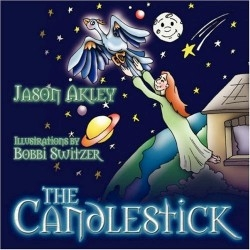
The Candlestick
A little girl who’s afraid of the dark goes to sleep one night and dreams of a candlestick. “A simple candlestick. Not very old. Just a plain candlestick made of gold.” This candlestick however is not an object in her possession—rather it is the object of an intellectual exercise or so says the enormous speckled bird that alights on her windowsill. “The dark is a mystery” says the bird “and many get lost in its way. I have come to give you a test. And the candlestick is at the end of your quest. But fear not. For it doesn’t matter if you lose or win. You never have to be scared of the dark again.”
As soon as the bird leaves so does everything else familiar and the little girl is whisked through seven different scenarios all involving animals. The author states that The Candlestick was inspired by the first three chapters of Revelations and the epistles of Saint Paul. “The seven types of animals represent the seven churches of the epistles seven types of Christians and seven dispensations of time.” Law free will faith and consumerism are all touched upon rather in the way a stone skips across a pond. The instruction is based on a kind of Zen master/Socratic method where the little girl asks questions which are then answered with riddles or more questions. When the girl questions the method a pig says “Be still little girl. You’re not alone. It’s the questions you ask that will take you home.”
While the home message is a sound one of self-knowledge forgiveness and love parents and children will be perplexed by the complexity of the text. How old do children have to be before they understand the concept of enlightenment (without explanation) or “Cartesian schemes.” While the illustrations suggest a youthful audience the lack of direction will lose listeners and confound readers. The author’s insistence on rhyme often drives the sense (or non-) of the sentence. Common misspellings add to the feeling of muddle. The Candlestick fails both to entertain and illuminate.
Disclosure: This article is not an endorsement, but a review. The publisher of this book provided free copies of the book and paid a small fee to have their book reviewed by a professional reviewer. Foreword Reviews and Clarion Reviews make no guarantee that the publisher will receive a positive review. Foreword Magazine, Inc. is disclosing this in accordance with the Federal Trade Commission’s 16 CFR, Part 255.
